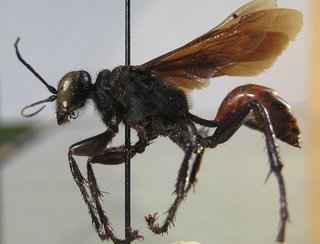
Native Bee Inventory and Monitoring Lab; Photographer: Erika Tucker · 1
Palmodes dimidiatus 1 |
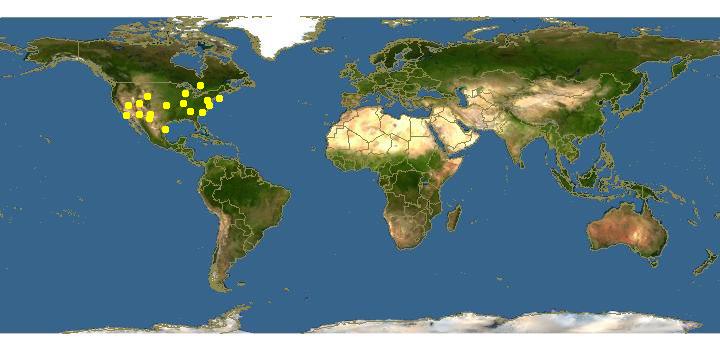
Click on map for details about points.
|
80x5 -
240x3 -
240x4 -
320x1 -
320x2 -
320x3 -
640x1 -
640x2
Set display option above.
Click on
images to enlarge. |
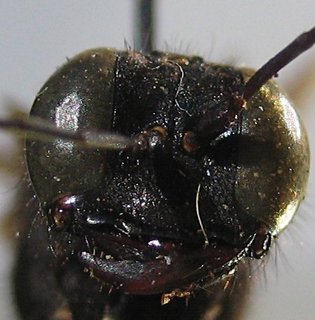
Native Bee Inventory and Monitoring Lab; Photographer: Erika Tucker · 1
Palmodes dimidiatus, face 2 |
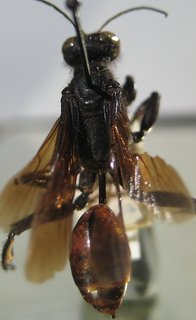
Native Bee Inventory and Monitoring Lab; Photographer: Erika Tucker · 1
Palmodes dimidiatus, top 4 |
|
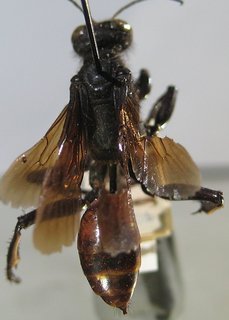
Native Bee Inventory and Monitoring Lab; Photographer: Erika Tucker · 1
Palmodes dimidiatus, top |
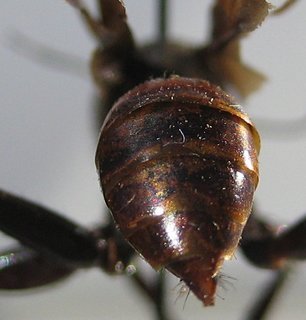
Native Bee Inventory and Monitoring Lab; Photographer: Erika Tucker · 1
Palmodes dimidiatus 3 |
|
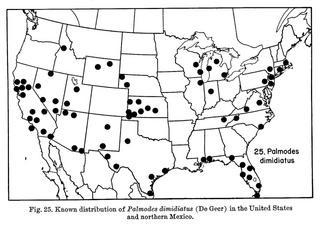
Bohart, R.M., Menke, A.S. 1963 · 0
Palmodes dimidiatus, map |
|
Overview |
Taken from:
Bohart, R.M., Menke, A.S. 1963. A Reclassification of the Sphecinae: With a Revision of the Nearctic Species of the Tribes Sceliphronini and Sphecini.
Male—Average length 15 mm; head and thorax black; gaster all black or segments I and II and sometimes base of III red; wings uniformly dark brown; body without silvery appressed pubescence; dorsum of thorax moderately and closely punctate, dull; propodeal enclosure finely cross striate; petiole nearly bare on distal one-half above; genitalia illustrated by Bohart and Menke (1961, fig. 15). .
Female.—Average length 20 Thin; gaster all red or with segments IV—VII black, rarely all black (Nebraska specimens) ; sternite VI with six to eight stout bristles on either side of median ridge; broad clypeal truncation illustrated by Bohart and Menke (1961, fig. 7).
|
|
|
Names | |
Palmodes dimidiatus (Be Geer)
(Fig. 25)
Sphex dimidiatus De Geer, 1773, Mem. Hist. Insect., 3:587. Holotype ♂, Pennsylvania (STOCKHOLM).
Sphex rufiventris Cresson, 1872, Trans. Amer. Ent. Soc., 4:211. Holotype ♀, “Tex.” (ANSP). ,Sphex abdominalis Cresson, 1872, Trans. Amer. Ent. Soc., 4:211. Holotype ♂, Texas (USNM). Preoccupied by Sphex abdominalis Drury, 1773.
Chlorion rufiventris opuntiae Rohwer, 1911, Proc. United States Natl. Mus., 40:257. Holotype ♀, Texas (USNM).
Sphex daggyi Murray, 1951, in Muesebeck et at., United States Department Agric. Monogr. no. 2, p. 974. New name for abdominalis Cresson.
|
|
|
Geographic distribution | |
Distribution—P. dimidiatus occurs from coast to coast in the United States and ranges south into northern Mexico (fig. 25).
|
|
|
Natural history | |
The authors have studied Be Geer’s type. Schulz (1912) pointed out the priority
of Be Geer’s name over abdominalis Cresson, but subsequent authors neglected
his note. We have studied the types of rufiventris, abdominalis, and opuntiae. This species is rather variable in color. In the eastern United States both sexes have the gaster red and black, but in other parts of its range the gaster is usually all red in the female. In the southwest and Mexico, males sometimes have an all-black gaster, whereas some Arizona males have an all-red gaster. We have seen a series from northwestern Nebraska in which both sexes are entirely black. The all-black males of dimidiatus are difficult to separate from carbo males, but the genitalia show slight differences and carbo is usually more robust and more densely hairy.
Biology.—Williams (1913) cited the tettigoniid Stipator as prey. Krombein (1953) observed dimidiatus using Atlanticus pachymerus (Burmeister) as prey, and the same author (1955b) reported the nest to contain a single cell.
|
|
| Supported by | |
Updated: 2024-04-25 20:04:13 gmt
|